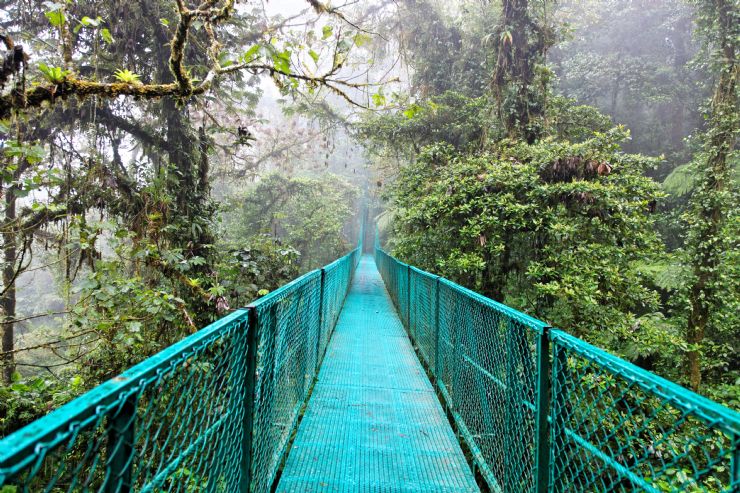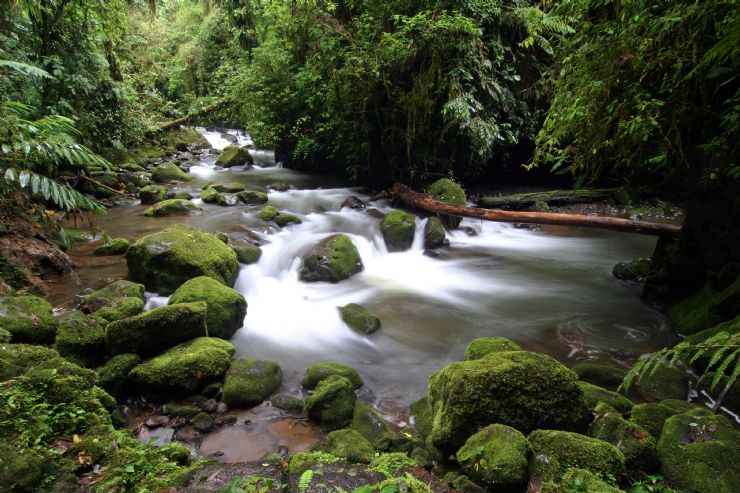
Beautiful suspension bridge in Monteverde
There are many wonders in Costa Rica, mainly because of the country's unmatched biodiversity.
While Costa Rica's total land mass may not be impressive, the amount of different species that occupy that small area is certainly impressive.
Some of the species, including wild cats, monkeys and birds, live in the many different types of forests in Costa Rica; many of which are part of a National Park, reserve or refuge. These areas are also home to species of plants and trees numbering in the tens of thousands.
The forests also offer visitors the chance to have adventures that will last a lifetime - from canoeing to zip lining to hiking.

Tropical Rainforest hike in Matapalo next to a Strangler Fig Tree
1. Costa Rica Tropical Rainforests
Travelers to Costa Rica can find the well-known, popular tropical rainforest areas in the southwest region, as well as in the lowland Atlantic regions.
Rainforests are filled with huge trees and receive large amounts of precipitation.
A canopy is created by the towering trees of the rainforest (some reaching almost 200 feet high!), which blocks the penetration of sunlight and limits the amount of vegetation that is present on the ground of the forest.
The rainforests in Costa Rica can see over 200 inches of rain annually, which sustain its climate and ecosystem.
Rainforests are mostly known for the vast numbers of species that live within them. From animals to plants, Costa Rica's rainforests are one of the most amazing places on the planet.
Home to mammals, birds, amphibians, fish and reptiles, there is always something exciting to see, and hear during a visit.
You will often hear monkeys howling and birds singing in the canopy of trees, while frog's voices fill the air closer to the ground. Sloths, frogs, snakes and bats also call the rainforest home. Not often seen in the rainforest are larger cats, like jaguars and pumas, but they are present.
The rainforest waters are also a place to find even more species that make up this unique ecosystem.
While hiking is a popular activity when visiting a rainforest, there are many other ways to enjoy the surroundings. From rafting to zip lining to bird watch, there are many vantage points you can take to immerse yourself into the unique landscape.
7 Days / 6 Nights
Starting at $779 per person

Cloud Forest at Santa Elena National Park sanctuary
2. Costa Rica Cloud Forests
The cloud forests of Costa Rica offer visitors a magical experience that engages the senses.
Seeing the mysterious fog, feeling the damp air, hearing the sounds of nature these are all things that happen to visitors of the cloud forests, which are found across the country in the high slopes of the local volcanoes and mountains.
The cloud forests are in protected areas, like the Monteverde Cloud Forest Biological Reserve, Santa Elena Cloud Forest Reserve, and the Los Angeles Cloud Forest Reserve.
These forests get their name because they are blanketed in clouds. The environment of clouds is formed as a result of the air cooling as it is pushed up the mountain slopes; what appears as clouds or fog is actually condensed water vapor.
The overall sight of a cloud forest isn't the only thing that is enchanting about it. The biodiversity within a cloud forest is not as numerous as that of a rain forest, but it is highly endemic.
Visitors can see wildlife in Costa Rica cloud forests that they literally cannot see anywhere else in the world. The range of species varies throughout each reserve; the Monteverde Reserve houses all six species of big cats, while the Santa Elena houses the spider monkey.
Cloud forest activities will leave a breathtaking impression on visitors. From insect museums, butterfly farms and bird watching expeditions, there is a lot to discover at a cloud forest reserve.
A day of hiking is anything but boring too, as just being surrounded by the sights and sounds of the forest is an adventure in itself. There are also adventure activities, including zip lining and walking over suspension bridges on top of the canopy.

Tropical Dry Forest surrounding the road to Guanacaste National Park
3. Costa Rica Tropical Dry Forests
As the name implies, the tropical dry forests of Costa Rica receive much less precipitation than the rainforests and cloud forests.
The tropical dry forests are located in lower elevations on the North Pacific coast of Costa Rica, in Guanacaste province. Like the other forests, dry forests are part of the country's national parks.
The national parks that are made up of dry forests include:
The tropical dry forests are less dense, so visitors might have more luck spotting the diverse wildlife that calls these areas home.
Monkeys, birds and cats can be found here, along with some truly stunning trees and flowers. Visitors can also spot scorpions, snakes and lizards on the ground.
Hiking trails are common and wind through each of the national parks, allowing visitors to be surrounded by all that the forest has to offer. Hikes are a great opportunity to watch wildlife and to take some amazing photos and videos. Adventure seekers can also enjoy biking, kayaking and horseback riding.

Mangrove at the Amazing Sierpe Terraba
The Mangroves are found along the Pacific coast in Costa Rica.
This unique ecosystem is formed where salt and freshwater meet, transitioning from dry to wet forests. This region experiences low annual rainfall and severe dry seasons.
The external regions of these areas are wetter and the internal areas are isolated from the water, though can be inundated with seasonal tides.
Costa Rica has seven species of mangrove trees, and the roots of the trees lie above the water, appearing to prop the trees up. These trees help stabilize the area against the tide and storm surges, and the root system also offers protection from predators for the local wildlife.
While there isn't much diversity in the extreme conditions of the mangroves, the region serves as a nesting site for birds and also hosts marine life.
Snakes, monkeys, bats and iguanas can be found in the habitat, along with crabs, lobsters, shrimps and more in the water. Visitors can book a tour to explore the waterways and ecosystem of the mangroves.

Lowland Rainforests meets the beach at Cahuita on the Caribbean coast of Costa Rica
5. Costa Rica Lowland Rainforests
The lowland rainforests in Costa Rica can be found in areas with an elevation of up to 1,000 meters. These areas experience high rainfall and have warm temperatures consistently throughout the year.
Lowland rainforests contain trees taller than in other forests, and support a variety of life. The environment is suitable for growth and reproduction all throughout the year, to the benefit of local plant and animal species.
The forest's trees help create a layered ecosystem that supports niche micro environments, adding to the diversity that can live there.
The lowland forests are filled with many creatures, big and small, including pumas, birds, bats and tree frogs. Besides the exotic wildlife, there are also many plants and waterways to discover.
Visitors can enjoy aerial trams, hiking, rafting and biking in these regions as part of their exploratory adventure tour.

Riparian Forest near a river in the Tilarán Mountain Range
6. Costa Rica Riparian Forests
Riparian Forests can be found near river, streams and other bodies of flowing water.
These forests are adjacent to the water, and are prone to inundation. The forest along the Rio Chirripo is one example of a riparian forest in Costa Rica.
With moisture and high humidity, this habitat is ideal for many land and water animals, many of which have adapted to and now require this unique environment.
Many bird species call the riparian forest home, including hummingbirds. Visitors can enjoy hiking, water activities and bird watching.

